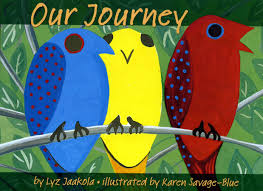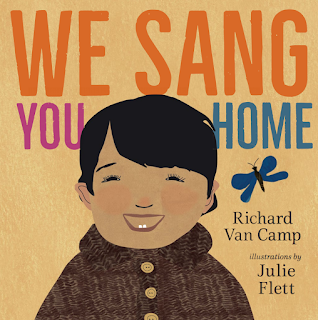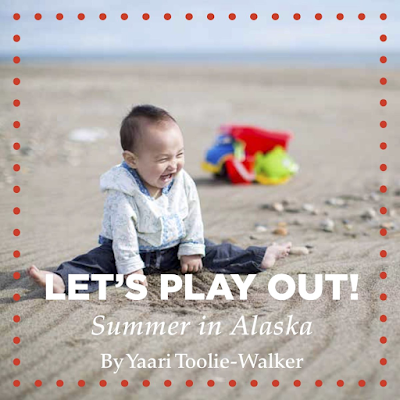Cradle Songs of Southeast Alaska
Written by Kaal.atk' Charlie Joseph (Tlingit), Hlii'ilaang Kun 'Lan-gaay
and HlGaa'xatgu 'Laanaas family members (Haida),
the Haayk Foundation, and Nancy Barnes (Tsimshian)
Illustrated by Crystal Kaakeeyaa Worl (Tlingit Athabascan)
Xaad Kil translations by Skil Jaadei (Linda Schrack),
Kwiigaay I'waans (Phyllis Almquist), and Ilskyalas (Delores Churchill)
Sm'algyax translations by the Haayk Foundation
Published in 2019
Publisher: Sealaska Heritage
Reviewed by Jean Mendoza
Status: Highly recommended
Cradle Songs of Southeast Alaska is part of Sealaska Heritage's Baby Raven Reads program. It's a multilingual board book -- three Tlingit songs, three Haida spoken-word poems, and three Tshimshian songs, each with English translation on the same page. Its companion CD features a bonus track: a Tlingit version of Twinkle Twinkle Little Star sung by
Keixwnei Nora Marks Dauenhauer.
Crystal Kaakeeyaa Worl's (Tlingit Athabascan) illustrations are quite appealing. Worl places formline figures amid washes of color and stylized natural features (such as clouds, water, flowers), and includes images of "everyday" tools such as a halibut hook and a berry basket. Some images are contemplative, and others have a lot going on. There's plenty to talk about with little ones on each page.
"Cradle songs" are not necessarily lullabyes! Don't expect to rock the baby to sleep with the book's companion CD. Some of these songs have a lively beat and are about activities like fishing for halibut and picking berries. Some are about family time -- like the Haida spoken-word piece that describes something that often happens when there's a newish baby at a family gathering. The English translation is:
Come, let us take the baby on our knees!
Come, let us take the baby on our knees!
Hand the baby to one another inside of her father's house,
hand the baby to one another!
The sweet memories that one brings to mind! Handing babies around!
The book's back matter explains important facts about its content. "Most songs in Southeast Alaska Native culture are restricted from general public use because of clan or family ownership," the statement begins. Debbie Reese has pointed out many times that some aspects of Pueblo ceremonies and religious ways of being are not to be shared with outsiders. The metaphor she uses is that of a
curtain drawn between those things and the parts of Pueblo life that can be shown to others.
The publisher goes on to say, "The songs in this book include traditional songs in the public domain and original works reprinted here with permission." As an outsider, I could be missing something, but to me it looks like Sealaska Heritage has made sure all songs are carefully attributed. If there's a problem I haven't noticed, I hope someone will let us know!
The CD liner notes contain additional details. Two of the Tlingit songs are attributed to
Kaal.atk' Charlie Joseph, and one to Clara Peratrovich. The Haida songs are "adapted from songs owned by" two families. The Tsimshian songs are contemporary, composed in English and translated into Sm'algyax by the Haayk Foundation. So it does appear that
Cradle Songs shares nothing that ought to stay behind that curtain Debbie talks about.
Performers on the CD are
Ed Littlefield (Tlingit),
Skil Jaadei (Haida),
David R. Boxley (Tsimshian),
Nancy Barnes (Tsimshian), Nancy Evelyn Barnes, and Katie Price. They all enunciate the words in each of their languages so clearly that I can discern even the sounds that are unfamiliar to English speakers, such as differences in vowel length, and what language specialists call pharyngeal consonants. Most of the songs have repetitive wording, and all are short enough to be repeated in full in less than a minute. All that repetition is good for teaching beginners the sounds, syntax, and grammar of a language.
If you're a parent or grandparent concerned about Tlingit, Haida, or Tsimshian language preservation,
Cradle Songs of Southeast Alaska seems like a great addition to your family collection of books and CDs. Even if you don't plan to learn or teach any of those languages, Worl's illustrations can spark conversations, and the English versions of the songs tell brief but interesting stories. Besides, research suggests that hearing different languages is good for infants' brains.
You can
order Cradle Songs of Southeast Alaska directly from Sealaska Heritage, and take a look at more of their
language preservation resources, too.
Here's just one more of these cradle songs.
The English version is:
Whose little girl is that
Packing something up the hill?
What is that chubby little girl up to?
Is that my daughter?
That's her! That's her!
See what's in the arms of that "chubby little girl?" BOOKS! I love it! I hope Sealaska Heritage has more like this one in the works!





























